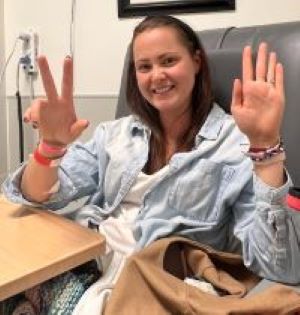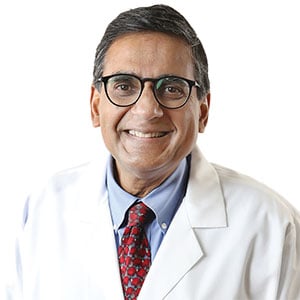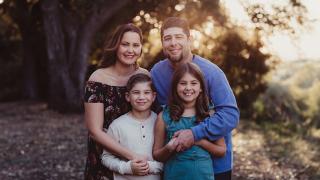“I’m relentless. I’m a ‘go-go-go’ person!”
Alisa Secaida learned early on how to compete, how to keep looking forward despite setbacks and how to fight the righteous fight. Her “get-it-done” attitude informs her life, and quite possibly may have saved it.
She grew up in a family dynamic she calls “complicated”: Five sisters, two brothers, lots of moving around, Mom and Dad not always there. By the time she was 10, Secaida had lived in Colorado, Arkansas and Arizona, ultimately moving in with her grandparents in West Covina, California.
She remembers being a healthy, active child. At college she studied anthropology, but a recession persuaded her to take a very different kind of job, selling steel rebar at her uncle’s company. She liked the steady paycheck. She stayed for 18 years.
Now 37, Secaida has built her personal corner of the American Dream in nearby La Verne, California, where she and her husband Aldo, an e-commerce professional, are raising their daughter Olivia, 9, and son Benjamin, 7.
She remembers the day, a little over two years ago, when she had to sit the kids down and tell them, “Mommy is sick.”
“I mean, young children are all Santa Claus and unicorns,” she said, fighting back tears. “Having to tell them about this was heartbreaking. But we had to be honest about it. We never wanted them to think they were lied to.”
Early Lung Cancer Symptoms
It was late December 2020 when Secaida began to suspect something was wrong. She was coughing. She felt fatigued. Breathing became difficult. Her chest felt tight, and her shoulder ached. One local doctor suspected asthma and gave her an inhaler. Her symptoms worsened. A second doctor blamed long COVID and told her to ease up on her schedule. “They said I was working too much,” she recalled.

With doctors dismissing her distress, Secaida took matters into her own hands, cashing in a Groupon offer to pay for her own computed tomography (CT) scan. The test detected a mass in her upper left lung.
Secaida returned to her doctor for a referral to a lung specialist. She was shocked by his reaction. “He got angry!” she said. “He accused me of going behind his back.” The doctor delayed the referral for weeks, “until my husband chewed him out,” Secaida said.
At the pulmonologist, Secaida had a positron emission tomography (PET) scan, which is better at spotting cancerous cells than a CT scan. She expected to get the results in a few days. The doctor phoned as Secaida was driving home. “Something’s wrong,” he said, “and it looks like cancer.”
Impossible, she thought. She didn’t smoke. No one in her family, including several smokers, had ever had lung cancer. And she was only 35! Doesn’t lung cancer strike older people?
“We are seeing more and more incidence of young people with lung cancer, especially women,” explained oncologist and lung cancer expert Ravi Salgia, M.D., Ph.D., professor and chair of the Department of Medical Oncology & Therapeutics Research and Arthur & Rosalie Kaplan Chair in Medical Oncology. “We don’t know why. We have to dig deeper.”
Lung Cancer in Non-Smokers
Although overall lung cancer rates have declined sharply, and patients under 45 make up a tiny fraction of total cases, as many as 14,000 younger people are diagnosed each year. Most tend to be women, many have never smoked and their malignancies are often detected at a late stage, after symptoms develop.
For Secaida, the next step should have been an immediate biopsy, but here again she had to fight. Several doctors refused to perform the procedure, claiming it was too risky. While it is true that a lung biopsy can occasionally cause chest infections or collapse the lung, there is no other way to accurately measure a tumor’s stage, a critical element in determining treatment.
It took a few weeks, but Secaida finally got her biopsy, and was told, “You need to see an oncologist.”
Secaida headed straight for City of HopeÒ, a short distance from her La Verne home.
“I’d driven by the place for years,” she said. “I knew co-workers who had relatives treated there. My heart and mind just told me I needed to be there.”
In November 2021 — nearly a year since she’d first experienced symptoms — she found herself sitting in Salgia’s office.
“I was in tears. I was shaking,” she recalled.
Salgia, a leader in the field with over three decades’ experience (“I’ve listened to more than 350,000 lungs,” he says) sought to reassure the terrified person seated before him. That part came naturally.
“He walks in, and he just calms the environment with his demeanor,” said Secaida. “He listens. He makes you part of the treatment team. There’s no ego, like with other doctors. He puts the patient first. You just know he has your back. I put my trust in him, and it was a tremendous weight off my shoulders.”
Stage 4 Lung Cancer Diagnosis
Nevertheless, her diagnosis was serious. Secaida had Stage 4B nonsmall cell lung cancer. A cancerous lesion was detected on her brain as well.

Secaida assumed surgery would be performed. “I felt that’s what people with cancer did to remedy it. You cut it out!” Secaida recalls. However, “Dr. Salgia explained to me that since I was Stage 4B and the cancer had already spread that surgery would not be the best option. Now I have come to understand that the best approach for metastatic cancer is to try to shrink it down with systemic therapies and/or radiation while leaving as much of the body intact as possible.”
As an initial step, every cancer patient at City of Hope gets genetic testing to see if their tumors display anomalies that can be matched to the new class of targeted therapy drugs. Secaida’s screening turned up nothing unusual.
Salgia started his patient on Keytruda (pembrolizumab), a monoclonal antibody that stimulates the immune system to destroy cancer cells, plus the chemotherapy drugs carboplatin and pemetrexed.
Her side effects were relatively minor. “I had some fatigue, some nausea,” she recalled. “I made a point of getting out and moving around after every treatment. That helped me feel better.”
Meantime, radiation oncologist Arya Amini, M.D., used stereotactic radiosurgery (SRS) to pinpoint and destroy Secaida’s brain lesion.
No Evidence of Disease
By July 2022, Secaida was designated as NED: no evidence of disease, a welcome development.
But there was a problem.
Ten rounds of Keytruda had left Secaida with liver toxicity, pointing up the unfortunate reality of cancer treatment.
“Every therapy can have toxicity,” said Salgia.
Secaida may have been especially vulnerable. A type 1 diabetic since age 21, she’d been coping for more than a decade with that autoimmune disease. Keytruda can sometimes trigger an autoimmune attack in such patients.
Salgia stopped the Keytruda treatment. “That panicked me,” said Secaida. She worried about a recurrence. “But Dr. Salgia said it was more important at that moment to fix the liver.”
A course of steroids took care of the liver problem, but in January 2023 her cancer returned. However, along with it came an encouraging surprise.
Further testing revealed that Secaida’s cancer did in fact have an actionable anomaly: Her tumor was anaplastic lymphoma kinase (ALK)-positive and could be treated with targeted therapies specifically designed for that genetic mutation.
With only about 4% of lung cancer tumors exhibiting this mutation, “ALK is like winning the lung cancer lottery,” Secaida said. “It responds better to the medication, and it’s generally associated with a longer survival rate.”
Why wasn’t ALK discovered at the beginning?
“These things can hide,” said Salgia. “It’s not clear why. But finding it is sometimes like looking for a needle in a haystack.”
New drugs known as tyrosine kinase inhibitors (TKI) work especially well on ALK-positive cancer. Secaida began taking one of them, alectinib, and she remains on it today. Her cancer is under control, and she and Salgia are cautiously optimistic.
“I feel good. I don’t feel like I have cancer,” she said. “I know things could turn bad, or I could go on much longer than expected.” She also knows that had this happened to her 10 years ago, before so many recent and remarkable advances, in all likelihood she would not have survived. But Stage 4 cancer no longer carries a universally grim prognosis.
“We’re seeing light at the end of the tunnel,” said Salgia. “We’re identifying mutations, developing immune therapies and we’re seeing better responses. But we can’t rest. We’ve come this far, but we must cure metastatic disease.” As for Secaida, “I hope she continues for a long time.”
Secaida knows her insistence on getting properly tested and ignoring the doctors who belittled her symptoms made a profound difference. So did choosing City of Hope and finding Salgia.
“If I had gone to some run-of-the-mill oncologist, I probably wouldn’t be here now,” she said. “I wholeheartedly believe that City of Hope and Dr. Salgia have my best interests at heart. Their goal is to give their patients as much time with their loved ones as possible.
“I owe them a great debt.”
